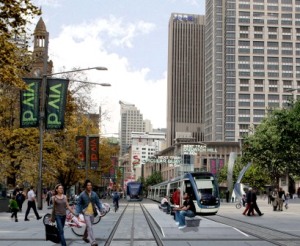 |
| Artist's impression of George Street Sydney with the light-rail extension. Image: City of Sydney. |
The City of Sydney has welcomed the New South Wales Government’s announcement that George Street will be included in a light rail feasibility study.
Lord Mayor Clover Moore said light rail along the city’s busiest street would transform central Sydney into a “pedestrian friendly, efficient transport corridor that people would actually enjoy using”.
“With capacity for at least 4500 passengers per hour, light rail along George Street could remove long queues of buses from the City centre, ease CBD congestion, and make it easier and quicker for people to get from northern, central and southern Sydney into the city,” Cr Moore said.
“A north south surface transport spine would allow significant interchanging from bus to light rail, particularly for inbound buses from the lower north shore, hills district and northern beaches, many of which already terminate at Carrington Street, less than 100m from George Street.”
She said a light rail service that travelled from the new Barangaroo development, to the Rocks, Circular Quay, Town Hall, Chinatown and Haymarket, would provide a “stunning link for our major cultural institutions, celebrating our City's harbour foreshore”.
The Urban Taskforce has also applauded the decision to include George Street in the study.
The Urban Taskforce’s chief executive, Aaron Gadiel, said a light rail extension would provide for new compact, mixed-use neighbourhoods.
“We strongly support the Government’s investment in new light rail services,” Mr Gadiel said.
“Investment in infrastructure, such as light rail, will inspire confidence and encourage private sector investment in urban renewal projects along the route.”
He recommended that the study also considered the need for “secure strong patronage” on new services.
“Patronage on the light rail system will be strongly influenced by the type of urban development that is encouraged in the vicinity of its stops,” Mr Gadiel said.
“Compact, mixed-use development will be critical to the success of this transport project.”





Leave a Reply